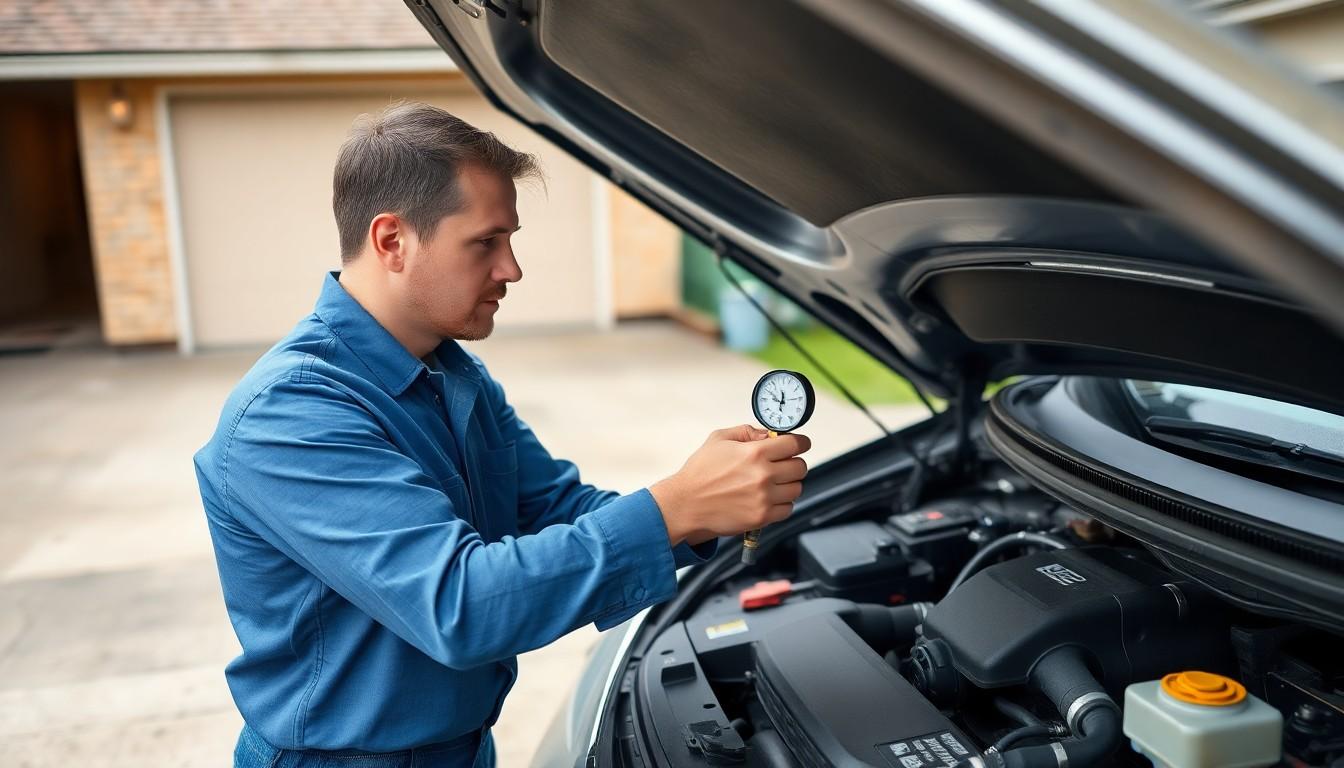Is your car’s AC not cooling as it should? Before rushing to a mechanic, you might want to check your car’s freon levels yourself. Low refrigerant (commonly called freon) is often the culprit behind a struggling air conditioning system, and diagnosing this issue is simpler than you might think.
We’ve put together this straightforward guide to help you check your car’s freon levels at home. With just a few tools and our step-by-step instructions, you’ll be able to determine if low refrigerant is causing your AC problems. Not only will this save you a potentially unnecessary trip to the shop, but it’ll also help you understand your vehicle better.
Understanding Freon and Its Role in Your Car’s AC System
Freon (or refrigerant) serves as the lifeblood of your vehicle’s air conditioning system. Modern cars typically use R-134a or the newer R-1234yf refrigerant rather than the original Freon (R-12), which was phased out due to environmental concerns. These refrigerants transfer heat from inside your car to the outside, creating the cooling effect you feel when the AC runs.
Your car’s AC system operates through a continuous cycle of pressure changes that allow the refrigerant to absorb and release heat. Refrigerant flows through five main components: the compressor, condenser, expansion valve, evaporator, and accumulator/receiver-drier. Each component plays a vital role in transforming the refrigerant from a low-pressure gas to a high-pressure liquid and back again.
Low refrigerant levels drastically reduce your AC’s cooling efficiency. Signs of refrigerant issues include warm air blowing from vents, unusual noises from the AC compressor, and visible refrigerant leaks (appearing as oily residue near AC components). Unlike oil or other fluids, refrigerant doesn’t get “used up” during normal operation—it circulates continuously in a closed system.
Refrigerant leaks pose both operational and environmental concerns. Even small leaks gradually degrade AC performance over time, while refrigerant released into the atmosphere contributes to ozone depletion and global warming. That’s why proper handling of refrigerant requires certification, and why it’s illegal to intentionally vent refrigerant into the air.
Checking refrigerant levels gives you valuable information about your AC system’s health. Low levels almost always indicate a leak somewhere in the system. Finding and fixing these leaks not only restores cooling performance but also prevents further environmental damage and helps avoid more expensive repairs later.
Signs That Your Car May Be Low on Freon

Recognizing the symptoms of low refrigerant levels can help you diagnose AC problems before they worsen. These indicators often appear gradually but shouldn’t be ignored as they signal potential issues with your air conditioning system.
Warm Air Coming From Vents
When your car’s AC blows warm or only slightly cool air, it’s a primary indicator of low Freon levels. The air conditioning system relies on sufficient refrigerant to cool the air effectively. Even if you feel some cooling effect, inadequate refrigerant prevents the system from reaching optimal performance, resulting in air that’s cooler than ambient temperature but not as cold as expected. This symptom typically develops progressively, with cooling becoming less effective over time as refrigerant levels continue to drop.
Strange Noises From the AC System
Unusual sounds emanating from your vehicle’s air conditioning components often signal refrigerant problems. Listen for hissing noises, which commonly indicate refrigerant escaping through small leaks in the system. Bubbling sounds suggest air has entered the lines due to low Freon levels. Clunking or rattling from the compressor area points to the unit struggling to function with insufficient refrigerant. These acoustic warnings typically occur during AC operation and merit immediate attention to prevent further damage to your system’s components.
Tools and Materials Needed for Checking Freon Levels

Checking your car’s AC refrigerant levels requires exact tools to ensure accurate measurements. Here’s what you’ll need to properly assess whether your system has enough freon:
- Thermometer – A specialized thermometer measures the temperature differential inside your vehicle before and after activating the AC system. This reading helps determine if your air conditioning is cooling effectively.
- AC Gauge Set – These gauges are essential for accurately measuring the pressure within your AC system. The set typically includes two separate gauges: one for the high-pressure side and another for the low-pressure side of the system.
- Safety Gear – Gloves and safety glasses protect you when handling refrigerant components, as contact with the skin can cause frostbite.
- Service Manual – Your vehicle’s service manual contains manufacturer specifications for proper refrigerant pressure levels exact to your car model.
When identifying components of your AC system, locate the Schrader valve on the low side of the refrigerant lines (usually marked with an “L”). You’ll also need to distinguish between the refrigerant lines—the smaller line typically feels hot during operation, while the larger line should feel cold near the compressor when the system functions correctly.
Professional mechanics use specialized recovery machines to properly recycle and refill refrigerant, ensuring exact measurements according to manufacturer specifications. These machines help prevent environmental damage while maintaining optimal system performance.
Step-by-Step Guide to Check Freon in Your Car

Checking your car’s freon level requires a methodical approach to accurately diagnose refrigerant issues. Following these exact steps ensures you’ll get reliable readings and avoid damaging your AC system.
Locating the Low-Pressure Port
The low-pressure port on your car’s AC system is typically marked with an “L” or appears as the smaller port on a larger pipe. This critical access point is generally located near the compressor or receiver dryer in the engine compartment. Most vehicles position the low-pressure port in an accessible area at the front of the engine bay, making it relatively easy to reach without removing multiple components. Look for a metal pipe with a small cap that resembles a valve stem similar to those on your tires.
Connecting the Gauge to the System
Start your engine and turn the AC to its maximum cooling setting with the fan at highest speed to properly pressurize the system. Remove the dust cap from the low-pressure port you’ve located to expose the connection point. Attach the blue quick coupler fitting from your recharge kit or manifold gauge set to this port, ensuring the coupler is closed before connection to prevent refrigerant escape. Manifold gauge sets require careful handling – hang the setup securely and verify both valves remain closed before connecting any hoses. The yellow middle hose connects to refrigerant cans during recharging, though this isn’t necessary if you’re simply checking refrigerant levels.
Reading the Pressure Gauge Correctly
Gently open the valve on the quick coupler just enough to allow pressure readings to register on the gauge – complete opening isn’t required. Check the pressure reading with the engine running and AC on maximum – normal pressure typically falls between 30-50 PSI in a properly functioning system. Readings significantly below this range indicate low freon levels, often accompanied by visible bubbles in the receiver dryer window or a non-captivating compressor. Excessively high pressure readings might signal system overcharging or other complications requiring professional attention. Monitor the compressor during this process – if it fails to engage while testing, this suggests either critically low refrigerant levels or potential issues with the compressor clutch mechanism.
When to Refill vs. When to Seek Professional Help

DIY Freon Refill Considerations
Refilling freon yourself makes sense for those comfortable with DIY car maintenance and equipped with the necessary tools. The process requires connecting AC gauges to the low-side Schrader valve and adding the appropriate refrigerant. Many auto parts stores sell recharge kits containing refrigerant and gauges for this purpose. Visual inspections can guide your decision – if the receiver dryer shows liquid flow with minimal bubbles while the AC runs, your system likely has sufficient refrigerant.
Signs Professional Help Is Needed
Taking your car to a professional becomes essential in several situations. Important bubbling or foaming in the receiver dryer window indicates potentially serious refrigerant issues beyond a simple refill. Ice buildup on the evaporator coil or refrigerant lines suggests problems that require expert diagnosis. Systems needing evacuation and recharging demand specialized equipment that professionals use to prevent refrigerant from escaping into the atmosphere.
Complex AC System Issues
Mechanics should handle your AC system when symptoms point to more complex problems. Temperature discrepancies between refrigerant lines (the smaller high-pressure line should be hot while the larger low-pressure line should be cold) often indicate issues beyond low refrigerant. Leaks in the system must be repaired before adding new refrigerant to prevent immediate loss and environmental damage. Compressor damage from running with insufficient refrigerant represents an expensive repair that proper professional maintenance can help avoid.
Environmental and Safety Concerns
Professional handling ensures environmental compliance when dealing with refrigerants. Modern refrigerants can harm the ozone layer if released improperly, and technicians possess proper equipment to capture and recycle these substances. Safety concerns also favor professional service since refrigerants can cause frostbite on contact with skin and create hazardous gases if exposed to high heat. Certified mechanics understand these risks and take appropriate precautions while servicing your vehicle’s AC system.
Environmental Considerations and R-134a Alternatives

Freon-based refrigerants pose important environmental concerns due to their greenhouse gas properties. R-134a, commonly used in car AC systems, contributes substantially to global warming when released into the atmosphere. Professional mechanics use specialized equipment that captures and recycles old refrigerant during system checks or recharging, preventing harmful environmental impact.
Environmental responsibility requires careful handling of these substances to avoid atmospheric release. Any work involving refrigerants must be conducted using proper containment methods to minimize environmental harm. Recovery machines employed by certified technicians extract old refrigerant, process it for reuse, and precisely refill systems with the exact amount needed for optimal performance.
R-1234yf has emerged as a leading alternative to R-134a, offering dramatically lower global warming potential. This newer refrigerant represents an environmentally conscious option for modern vehicles but comes with important compatibility limitations. R-1234yf systems require different handling procedures and specialized equipment not interchangeable with those used for R-134a systems.
Car manufacturers have increasingly adopted these alternative refrigerants in response to environmental regulations. Understanding which refrigerant your vehicle uses is essential before attempting any AC system maintenance. The refrigerant type is typically listed on a label under the hood or detailed in your owner’s manual, helping ensure proper servicing techniques are applied.
Conclusion
Checking your car’s freon levels is a valuable skill that can help you diagnose AC problems before they worsen. With the right tools and knowledge we’ve shared you can now determine if low refrigerant is affecting your cooling performance.
Remember that while DIY checks are helpful modern refrigerants require careful handling for both environmental and safety reasons. If you’re unsure about any step don’t hesitate to consult a professional mechanic.
By staying proactive about your AC system’s health you’ll enjoy comfortable drives while potentially avoiding costly repairs. Your car’s cooling system will thank you and so will your passengers during those hot summer months!
Frequently Asked Questions
How do I know if my car’s AC is low on freon?
Look for warm air from vents (cooling that gradually becomes less effective), unusual noises (hissing, bubbling, or clunking sounds), and visible leaks around AC components. The compressor may also fail to engage if refrigerant levels are critically low. These symptoms typically develop over time rather than suddenly.
What tools do I need to check my car’s freon levels?
You’ll need a thermometer to measure vent temperatures, an AC gauge set for pressure readings, safety gear (gloves and eye protection), and your vehicle’s service manual. The gauge set is essential as it connects to the low-pressure port and provides accurate refrigerant pressure readings.
Where is the low-pressure port located in my car?
The low-pressure port is typically marked with an “L” and located on the larger diameter refrigerant line near the compressor or receiver dryer. It’s covered with a plastic cap and designed to connect with standard gauge sets. Check your vehicle’s service manual for the exact location in your specific model.
What is the normal freon pressure reading for a car AC?
Normal pressure readings typically fall between 30-50 PSI when the AC is running at maximum cooling. Readings significantly below this range indicate low refrigerant levels, while readings much higher could signal overcharging or other system issues. Always compare readings to your vehicle’s specific manufacturer specifications.
Can I refill my car’s freon myself?
Yes, if you’re comfortable with car maintenance and have the proper tools. However, if you notice bubbling in the receiver dryer, ice buildup on refrigerant lines, or leaks, seek professional help. Remember that refrigerant handling has environmental implications and requires proper equipment and knowledge.
What type of refrigerant does my car use?
Modern vehicles typically use either R-134a (common in cars made between 1995-2020) or R-1234yf (newer models after 2015). Check the label under your hood or consult your owner’s manual to determine your specific refrigerant type. Using the wrong type can damage your AC system.
Are car refrigerants harmful to the environment?
Yes. R-134a is a significant greenhouse gas when released into the atmosphere. Newer R-1234yf is more environmentally friendly but still requires proper handling. Professional mechanics use specialized equipment to capture and recycle refrigerants during servicing to prevent environmental damage.
How often should I check my car’s freon levels?
Check refrigerant levels annually before summer or whenever you notice reduced cooling performance. Regular monitoring helps catch leaks early and prevents damage to expensive components like the compressor. Most vehicles shouldn’t lose refrigerant under normal conditions unless there’s a leak.

















